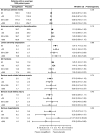Effect of Canagliflozin on Renal and Cardiovascular Outcomes across Different Levels of Albuminuria: Data from the CANVAS Program
- PMID: 31530577
- PMCID: PMC6830803
- DOI: 10.1681/ASN.2019010064
Effect of Canagliflozin on Renal and Cardiovascular Outcomes across Different Levels of Albuminuria: Data from the CANVAS Program
Abstract
Background: If SGLT2 inhibitors protect the kidneys by reducing albuminuria as hypothesized, people with type 2 diabetes mellitus (T2DM) with higher albuminuria should benefit more.
Methods: We conducted a post-hoc analysis of data from the CANagliflozin cardioVascular Assessment Study (CANVAS) Program, which randomized 10,142 participants with T2DM and high cardiovascular risk to canagliflozin or placebo. We assessed effects of canagliflozin on renal, cardiovascular, and safety outcomes by baseline albuminuria. The trial included 2266 participants (22.3%) with moderately increased albuminuria (urinary albumin/creatinine ratio [UACR] 30-300 mg/g) and 760 (7.5%) with severely increased albuminuria (UACR >300 mg/g) at baseline.
Results: Canagliflozin lowered albuminuria with greater proportional reductions in those with moderately and severely increased albuminuria (P heterogeneity<0.001). After week 13, canagliflozin slowed the annual loss of kidney function across albuminuria subgroups, with greater absolute reductions in participants with severely increased albuminuria (placebo-subtracted difference 3.01 ml/min per 1.73 m2 per year; P heterogeneity<0.001). Heterogeneity for the renal composite outcome of 40% reduction in eGFR, ESKD, or renal-related death was driven by lesser effects in participants with moderately increased albuminuria (P heterogeneity=0.03), but no effect modification was observed when albuminuria was fitted as a continuous variable (P heterogeneity=0.94). Cardiovascular and safety outcomes were mostly consistent across albuminuria levels including increased risks for amputation across albuminuria subgroups (P heterogeneity=0.66). Greater absolute risk reductions in the renal composite outcome were observed in participants with severely increased albuminuria (P heterogeneity=0.004).
Conclusions: The proportional effects of canagliflozin on renal and cardiovascular outcomes are mostly consistent across patients with different levels of albuminuria, but absolute benefits are greatest among those with severely increased albuminuria.
Keywords: SGLT2 inhibitor; albuminuria; canagliflozin; cardiovascular; renal.
Copyright © 2019 by the American Society of Nephrology.
Figures






References
-
- van der Velde M, Matsushita K, Coresh J, Astor BC, Woodward M, Levey A, et al. .: Chronic Kidney Disease Prognosis Consortium : Lower estimated glomerular filtration rate and higher albuminuria are associated with all-cause and cardiovascular mortality. A collaborative meta-analysis of high-risk population cohorts. Kidney Int 79: 1341–1352, 2011 - PubMed
-
- Gansevoort RT, Matsushita K, van der Velde M, Astor BC, Woodward M, Levey AS, et al. .: Chronic Kidney Disease Prognosis Consortium : Lower estimated GFR and higher albuminuria are associated with adverse kidney outcomes. A collaborative meta-analysis of general and high-risk population cohorts. Kidney Int 80: 93–104, 2011 - PMC - PubMed
Publication types
MeSH terms
Substances
LinkOut - more resources
Full Text Sources
Medical
Research Materials
Miscellaneous

